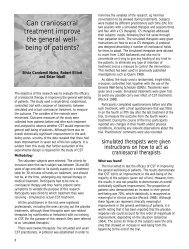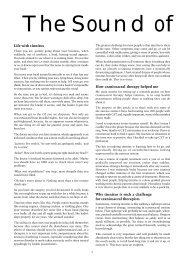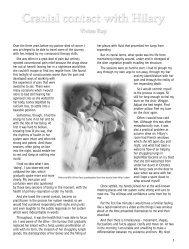Issue 24 2001 real thing.pm6 - The Craniosacral Therapy ...
Issue 24 2001 real thing.pm6 - The Craniosacral Therapy ...
Issue 24 2001 real thing.pm6 - The Craniosacral Therapy ...
You also want an ePaper? Increase the reach of your titles
YUMPU automatically turns print PDFs into web optimized ePapers that Google loves.
and the Cultivation of Equanimity<br />
mind also has a quality that is universal, not separate. At this<br />
level of awakening or just being quiet we are actually able to<br />
enter into the non-separate relational field. I am sure as<br />
practitioners you can translate what I am saying into your<br />
experiences of being still and quiet with a client: allowing<br />
every<strong>thing</strong> to be going on just as it is going on, knowing what it<br />
is you can know, and being all right not to know what you can’t<br />
know, accepting that there is much more there than you can<br />
possibly know in that moment in yourself or between your<br />
hands. At that moment there is synchrony, a mutuality, there<br />
is information that is available to you that is not coming through<br />
the normal routes. It is not being processed as - “this equals<br />
this, this equals this, ah, that is what is happening”. It is direct<br />
information.<br />
I am suggesting that experience is co-emergent as opposed to<br />
linear. <strong>The</strong>refore concepts of transference and countertransference<br />
are going to be changed. Whose material is this?<br />
Whose experience is this? Does it matter if we know, or is it<br />
perhaps more important that we meet the experience no matter<br />
where it is coming from?<br />
Awareness is curative<br />
And my final assumption is that awareness in itself is curative.<br />
That if we are able to open enough in the present moment,<br />
open to the experiential field, open to both our inner experience<br />
and what the impact of being with the client is, whilst holding<br />
that within an even wider field, if we are just able to be there,<br />
that awareness is curative. What does that make of someone<br />
who has just had twenty years in training? I know that our<br />
psychotherapists, when we suggest this, flinch just a little bit.<br />
But if awareness in itself is curative, if that is true, or even if it<br />
is partially true, why do we have to learn to become skilled in<br />
what we do? Well, I actually believe that being skilled in<br />
working with the various problems is very important. You<br />
have got to have some<strong>thing</strong> to do while healing occurs! I am<br />
being a bit facetious, but I do believe that if you are practising<br />
in a way that moves towards a depth of awareness, that moves<br />
you into the present moment with the other person, this will<br />
help clear some of the obscuration to the field of emptiness in<br />
which healing can occur.<br />
All beliefs are to be<br />
enquired into<br />
So, the task isn’t to heal or to diagnose. But of course we can’t<br />
stop doing that. I can’t stop doing that - I don’t know if you can<br />
stop doing that. I can stop doing it for a second or two at a time,<br />
but then judgements, thoughts, beliefs and ego keep churning<br />
this stuff up. If there is no<strong>thing</strong> coming up that is useful, I am<br />
not feeling good as a practitioner, but if some <strong>thing</strong>s are coming<br />
up that look as though they are useful - I feel good! If we are<br />
not aware of how to work with these ego processes, ego will<br />
obscure the healing.<br />
Equanimity<br />
When I first came across the term equanimity I thought it was<br />
some<strong>thing</strong> like peacefulness: calm, soft and expansive - a good<br />
feeling. Over the years I have come to believe that equanimity<br />
is the hardest earned experience for a practitioner. Equanimity<br />
simply means space for every<strong>thing</strong>. It is based to a large extent<br />
on our capacity to receive. If our capacity to receive is restricted<br />
- as of course it is because we are all limited - equanimity, or<br />
the possibility of there being space for every<strong>thing</strong>, is reduced.<br />
If you are open, you are not only open to the mind of the client,<br />
you are open to every mind in the universe. <strong>The</strong> experience of<br />
being open means that there is going to be an impact, you are<br />
going to be affected, be affected in good ways and in difficult<br />
ways, be affected cognitively, emotionally, energetically<br />
(particularly this, I imagine, in the work that you are doing)<br />
and psychically. It is not just a case of “ah, there’s this, there’s<br />
that, there’s the other”. It is a case, for most of us, of how can<br />
we host the effect of being a human being, how well do we host<br />
the effect of being a human being?<br />
I sort of scurry into London at the last possible minute, get my<br />
raincoat on, get on the tube and get off again and come to a talk<br />
like this, and get back on the train again, because for me coming<br />
to London occasionally is so overwhelming that I have few<br />
choices. I can either be so overwhelmed that I would probably<br />
cry at Paddington station and wouldn’t be here right now, or I<br />
can close down and can work within a much narrower limit of<br />
my potential experience. You have got your own ways of coping.<br />
But in the present moment with your client, how you are able<br />
to hold the impact of that present moment of co-emergent<br />
experience is one of the most important practices of the<br />
psychotherapist. I will give you some basic examples. You look<br />
at your schedule for the day and you go “uuggh!” Sometimes<br />
not even consciously, it just registers. Or you look at the name<br />
of the next patient, “aah, easy one!” I don’t think we can have<br />
too many “uuggh’s” and survive but actually they are <strong>real</strong>ly<br />
challenging. <strong>The</strong>y are challenging first of all because they<br />
challenge some<strong>thing</strong> in us. <strong>The</strong>y challenge our ability to have<br />
equanimity. <strong>The</strong> ones that are “oh, these are easy” are just as<br />
challenging because quite often we are asleep with them<br />
because we are not challenged. <strong>The</strong>y are all going well, they<br />
like us, we like them, they are similar to us - if they weren’t<br />
our client, they would be our friend. But they put you to sleep.<br />
<strong>The</strong> ones that give you that “uuggh”, they wake you up. We<br />
could actually be grateful for being woken up to our difficulty<br />
at receiving, but we also have to monitor our falling asleepness<br />
with clients. Some of it is just because it is easy, because there<br />
is no<strong>thing</strong> being challenged. In psychotherapy, it is called<br />
7





